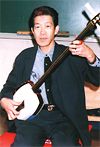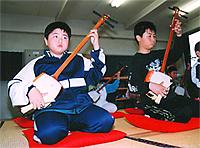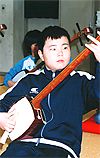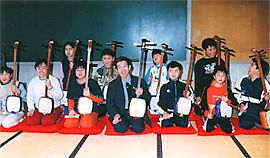 |
THE
ARTS
What youngsters go through to master a traditional craft or art. |
|||||
| The Shamisen Club at Kiraichi Elementary School | ||||||
 |
Kiraichi Elementary School is located in Kanagi, a small town in the northern
part of Aomori Prefecture where the tsugaru shamisen was born.
The school was founded 122 years ago, and its tsugaru shamisen
club practices every Saturday. The lessons are held to encourage youngsters
to develop an interest in this art form and keep this tradition alive.
The club was formed in April 1999, and 10 of the 28 fifth and sixth graders
at the school are now members.
What attracted these pupils to the shamisen? Ayumi Narita, a sixth grader who joined the club in November 1999, decided to give it a try after she saw her friend Mami Kon having a lot of fun playing it. Mami began learning in April 1999 along with her classmate Michitaka Sakamoto after their teacher recommended it to them. The other eight kids began studying in November 1999. |
|||||
 |
||||||
 |
Fifth
grader Hiroki Kogawa is one of them. "My friends were doing it, and it
looked like fun," he notes.
"My grandfather's been playing the shamisen for many years, so I thought I'd try it myself," adds Mari Sato, a sixth grader. "I love music, and I really enjoy playing instruments," pitches in Mai Kon, in fifth grade. The lessons are led by Manji Kudo, the 56-year-old head of the Manji school. He is one of the few people left who still makes tsugaru shamisen. The kids listen carefully when Kudo teaches, since there's no written score to fall back on. They watch him play and imitate his actions. They've learned how to use the bachi (pick), and now they're rehearsing for a recital scheduled for early October. |
|||||
 |
||||||
 |
Is
playing the tsugaru shamisen been as fun as it looked? "It's satisfying
to feel that you're getting better step by step," say six graders Kazuki
Kon and Shin'ya Munakata.
Fifth grader Jun'ya Ito comments, "I'm getting better at it now, but in the beginning I was completely lost." "The bachi was so big I had a hard time holding it at first," admits fifth grader Arika Kogawa. "I couldn't play at all for the first two or three months, so it was really tough," says Michitaka Sakamoto. It seems everyone has a hard time in the beginning. Do the kids practice much after school or on their days off? "My family runs a farm, so I'm usually helping out on the weekends," confesses Ayumi Narita. |
|||||
 |
||||||
| Mai
Kon is really good with her hands and says she spends a lot of her time
making rings with beads or knitting. She's given a bracelet made of beads
and a hand-knit woollen scarf to her teacher as gifts.
Mami Kon enjoys watching TV and playing video games. "When I get older I want to either run a coffee shop or become a martial artist." No one, it seems, is seriously considering a career as a professional shamisen player. Kudo says he's happy, though, with the progress his students have been making so far. "They're all very good students who are eager to pick up new things. Once they learn a part, they don't forget it, and they've been getting better all the time." |
||||||
| Photos (from top left): Manji Kudo teaches kids how to play the shamisen; The kids are steadily improving their skills through weekly practices; Listening closely to the teacher's instructions; The shamisen looks big when held by the kids; Club members gather for a photo. They are practising hard for an autumn competition. |